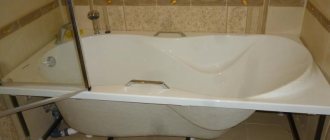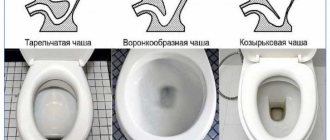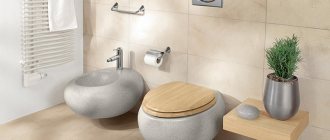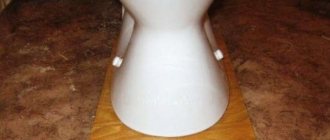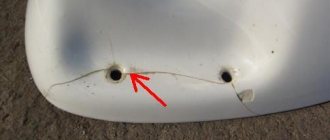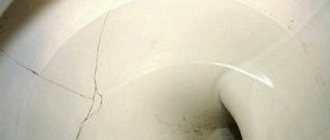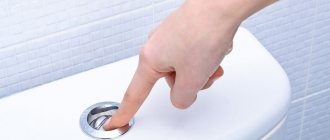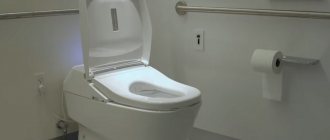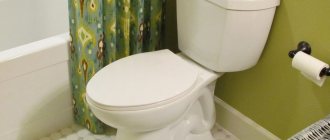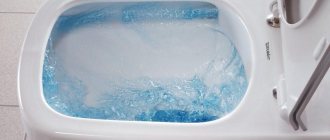- December 7, 2020
- Plumbing
- Polina Makarova
A toilet room is a room that, undoubtedly, exists in almost every house or apartment and is considered one of the traditional attributes of comfortable housing. This article tells you how to secure the toilet so that it does not wobble, and what methods of fixation are preferable to use if there is a need to change the toilet later for one reason or another.
As a rule, the installation of a toilet is carried out by contractors during the construction of housing, but in some cases the apartment owners will have to do this themselves. After reading these recommendations, you will understand how to strengthen the toilet quickly and correctly, without the help of a paid specialist.
Features of plumbing installation
Any toilet must be installed in accordance with the instructions. Installation of the device during the construction stage is usually carried out by experienced workers, but every self-respecting man should know not only how to reinstall this type of plumbing, but also how to secure the toilet so that it does not wobble.
As practice shows, when reconstructing a toilet, owners try to replace the toilet themselves in order to save money, although many do not know the nuances of installation and fastening methods. What to do if the toilet is wobbly? How to strengthen it? Here is an incomplete list of questions that sooner or later almost every owner will ask himself. Features of toilet installation depend on its type. Floor-mounted toilets are mainly used. If you want to understand why the toilet swings and how to strengthen it, then you need to familiarize yourself with the beginning - methods of fastening toilets.
Methods for fixing toilets to the floor
There are at least three methods of attaching the toilet to the floor:
- Using a standard installation kit (recommended for use only when installing on a perfectly flat floor).
- Using adhesives (the plumbing fixture is expected to last for a long time, without the possibility of its quick dismantling).
- By installing the device in cement mortar (the action is similar to glue, but is less durable and ensures easy removal of the product if necessary).
Depending on the chosen fastening method, the master will need a specific tool. It is recommended to always have on hand:
- hammer drill and set of drills;
- drill and drill bits for ceramics;
- push gun;
- a set of screwdrivers, wrenches, hammer and pliers;
- tape measure, spatulas, pencils;
- sandpaper.
Installing a toilet on the floor using standard fasteners involves drilling holes for dowels. Another method of installing a toilet - mounting it on bolts, screws or screws - is practiced more often than others, because most appliances go on sale with just such fasteners.
When installing a toilet on tiles, you should remember about the drilling technology (use a special drill at low rotation speed). Installation on cement also has its own nuances. An important factor in the quality of the connection is the composition of the solution. Here it is recommended to adhere to the ratio of one part cement to two parts quarry sand.
Which glue to choose
The cheapest way to glue a toilet to ceramic tiles is with a cement-based solution, but its seam will not always look aesthetically pleasing.
It will also be difficult to dismantle in the future, especially if the toilet is connected to a cast iron sewer. Liquid nails also work well, but it will be difficult to replace the plumbing fixtures with new ones. When using silicone, there is a high probability of the toilet moving or being damaged. Epoxy will quickly help to glue, but during dismantling there is a high risk that the tiles and plumbing will be damaged.
Cement mortar
Can be used if the toilet is installed for a long time. For installation you need a hammer, cement, and a chisel. The earthenware is installed in place, its outlet is connected to the sewer pipe, and the contours are outlined with a marker.
The toilet bowl is removed, and a notch is made on the tile along the drawn contour and a light chip of the top glaze is made with a hammer and chisel. This way improves the adhesion of cement to tiles. Actions are carried out wearing protective glasses.
A solution is prepared with or without sand. The consistency should be thick. The installation site is wetted, and a solution is generously applied to it along the marked contour. The toilet is placed on the solution and pressed slightly to the floor. Excess cement is removed with a rubber spatula.
Sealants
When choosing silicone sealant, you need to pay attention to its composition. Acetic. Has a strong smell and is inexpensive
Has a strong smell and is inexpensive
Acetic. It has a pungent odor and is inexpensive.
Neutral. Dear, can be used with any material.
Sealants are resistant to UV rays, adhere well to plumbing parts, are resistant to elevated temperatures, and form a flexible, beautiful seam.
- Ceresit Sanitary. A special sealant for plumbing, it can be used in areas of increased dampness. Provides good adhesion and prevents the spread of mold. Resistant to sunlight, has a long service life. Before applying the sealant, the surface must be cleaned to improve the adhesive characteristics of the material.
- Baumit Silicone. Does not allow the spread of fungus, is resistant to ultraviolet radiation, can be used at t=+5…+35 °C. Used for fixing interior plumbing fixtures and for tiling work. Resistant to high temperatures. Release form: 310 ml tubes.
Liquid Nails
Acrylic. It is based on a water emulsion.
Neoprene. Based on organic dye.
The mixtures are not susceptible to moisture and are resistant to mechanical damage. They set quickly, so installation is carried out very quickly. The following brands of compounds are suitable for installation.
- Belife is a one-component polyurethane composition. Has high initial adhesion force. Eco-friendly, safe for humans.
- LIQUID NAILS LN-901 – the product is suitable for damp areas. You can adjust the position of the glued parts for another 10 minutes. from the moment of application. Withstands t=-29…+60 °C, can be used indoors and outdoors. Dries completely within a day. This is a universal, durable composition that is resistant to mechanical stress.
- Titebond Multi Purpose is a universal product in a light beige shade. Has a viscous consistency. It hardens for half an hour, the parts adhere tightly. The adhesive is toxic and has a pungent odor, so all work with it is carried out in protective equipment. Resistant to dampness and low temperatures.
Epoxy adhesives
The adhesion of epoxy to any surface is ensured due to the ability to penetrate into the structure of the material. Epoxy-based adhesive is available in the form of a powder, paste or viscous mixture.
- EAF is a two-component composition of high strength. Has low shrinkage, can be used in damp objects. Has good quality at an affordable price.
- Moment is a heat-resistant composition. Available in the form of a plastic mixture. Forms a sealed joint, which after drying can be painted, polished, drilled.
- Contact – can be used in damp conditions. Hardens in a maximum of 2 minutes. It needs to be installed very quickly, since there is no time to correct the position.
Initial installation with screws. How to strengthen a toilet if it is wobbly
If you chose the first method of fixing the toilet to the floor or want to strengthen a wobbly toilet, then you need to follow these steps:
- Determine the exact place where the so-called sole will be located.
- Mark the mounting holes.
- Use a ceramic tile drill to drill holes no deeper than the thickness of the tile.
- Using a concrete drill, drill holes to approximately 6-7 cm.
- Insert the dowels from the kit.
- Place the plumbing fixtures in place, aligning the holes on the sole with the holes on the floor.
- Connect the toilet pipe with a hose to the sewer.
- Secure the toilet with screws.
Seal the connection points of the pipe to the toilet and sewer, and, if necessary, make cosmetic sealing of the gaps between the “sole” and the floor surface.
What parameters of a toilet chair should be taken into account when choosing?
dimensions
The distance between the handrails is important (if you don’t calculate it, the patient will not fit into the chair or will “dangle” in it, which is also inconvenient) - measure the circumference of the “user’s” hips and divide by two. Seat height is equally important, especially for people with sore legs: measure the distance from the lower thigh of the seated patient to the floor
Or look for a chair with telescopic legs. Permissible load - find out the exact weight of the patient. Hygienic slot shape. Round is inconvenient for men. Type of armrests - fixed - suitable for mobile patients who can sit down and stand up independently. For heavier ones, adjustable armrests are suitable - they can be lowered and they will not interfere with a person’s movement to and from the chair.
The product must be kept clean and ensure that it is in working order. It is unacceptable to use it if there are any damages: this is fraught with unnecessary injuries for an already unhealthy person.
Other mounting methods
Another method of attaching a toilet to the floor is called “taffeta mounting.” As a rule, it is used when installing plumbing fixtures on a wooden floor, where taffeta is a board cut along the sole of the toilet. First, the taffeta itself is attached to the floor, and then the toilet is attached to it.
A recess 5-7 cm deep is made in the floor, which is filled with cement mortar. Taffeta is taken, which is randomly punched with nails over the entire area. The side on which the nails came out is laid on cement.
The toilet is attached to the outside of the taffeta with screws. This is one of the easiest ways to secure the toilet so that it does not wobble, since in this case nothing needs to be screwed directly to the floor.
This method is gradually losing its relevance, in contrast to the relatively new one - installing plumbing fixtures on a frame - installation. In this case, the toilet is installed on a special frame - a metal installation disguised in the wall. In this case, we are talking about suspended installation, without much emphasis on the floor surface.
Safety precautions
In conclusion, some advice from the experts. They will help those who decide to eliminate all defects on their own. Following these recommendations will help you avoid accidents that could result in serious injury.
Experts advise:
- During any plumbing work, turn off the water supply to the apartment. This will save you from flooding in the event of an emergency.
- Use special clothing. Hands must be protected from cuts by wearing work gloves. There are always bacteria in the sewer system, which, if they enter the bloodstream, can cause serious infection. It is better to work in uncomfortable gloves than to lie in the hospital for a long time.
- When working with a hammer drill, use safety glasses, or best of all, a plastic shield that covers the entire face.
- Smoking and using open fire is prohibited. Sewer vapors are very volatile. Ignition can occur at any time.
- It is recommended to plug the drain hole with a rag. This will help avoid poisoning from inhaling its vapors.
Larisa, June 3, 2021.
- My piece of paradise. How to create a landscape design on your personal plot with your own hands?
- How color changes the mood of your home, experts say
Recommendations for installing toilets
It should be understood that plumbing fixtures are made from strong, but rather fragile materials, so during its installation you should be careful and calculate the forces, use soft pads for the screws. It’s not enough to know how to fix the toilet so it doesn’t wobble. You need to understand how fragile this plumbing fixture is and how much attention it requires.
When fastening with glue, you should take a responsible approach to cleaning and degreasing the surface, since the strength of the connection directly depends on this. When installing a toilet on taffeta, you need to choose strong wood or multi-layer plywood, but ensure good waterproofing for it. Using these tips, you can figure out how to secure the toilet so it doesn't wobble.
Conclusions and useful video on the topic
One of the options for attaching a plumbing fixture to the floor is discussed in the following video:
Which method of installing toilets is the best is up to the owner of the property to decide where the plumbing is to be installed and secured.
However, when choosing a technique, it is recommended to take into account the possible loads on the toilet, the material of the device (faience, porcelain), as well as the design features of the toilet room. A careful approach to business will definitely help you achieve the desired result.
Would you like to tell us how you installed the toilet yourself? Do you have useful information and photographs on the topic of the article? Please write comments, share your impressions and ask questions in the block below.
